Castleconnell is a picturesque village on the banks of the River Shannon situated in County Limerick. In 1250 the twin parishes of Stradbally and Killeenagarriff were incorporated into the Diocese of Killaloe, an island parish bordered by the River Shannon on one side and by the dioceses of Limerick and Cashel on the other sides. Within these parish boundaries are some notable historic ruins, those of Killeenagarriff Church and Inis Cluain. The present day churches of St. Joseph’s Castleconnell and St. Patrick’s Ahane make interesting reading as does St. Theresa’s Oratory in Montpelier. We shall endeavour to give you a brief history of our parish with particular emphasis on these places of Christian worship, beginning with Killeenagarriff Church.
Killeenagarriff Church
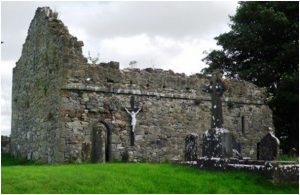 As the name suggests, Killeenagarriff means ‘the little church of the rough place’. The original church was built in the 9th century by the Ryan clan from Carlow. O’Donovan writing in 1839-’40 stated that ‘the old church is … constructed of small and large stones cemented with lime and sand mortar’. The west gable has a ‘small belfry constructed of ‘cut limestone’. According to Westropp (1905) the present church ‘is a fifteenth century building…it stands on a little stream, it is 36 ½ feet by 22 ½ feet.
As the name suggests, Killeenagarriff means ‘the little church of the rough place’. The original church was built in the 9th century by the Ryan clan from Carlow. O’Donovan writing in 1839-’40 stated that ‘the old church is … constructed of small and large stones cemented with lime and sand mortar’. The west gable has a ‘small belfry constructed of ‘cut limestone’. According to Westropp (1905) the present church ‘is a fifteenth century building…it stands on a little stream, it is 36 ½ feet by 22 ½ feet.
The east end fell before 1840. The south window has a trefoil headed light and oblong splay; the fabric of the church is of gritstone inside and limestone outside. The west end has a round-headed light and a bell chamber, with an ogee head cut in one stone. The walls are sixteen feet by three’. The priests of this church were secular priests and came from the prominent families in the area at the time, including the Mulryan’s, later shortened to Ryan and Heffernan’s. The following centuries were a time of relative peace and calm until the reformation, in the 16th century.
Fr. Heffernan celebrated the last Mass (of that period) there in 1648 as the building was destroyed and the Catholics driven from their church. The church was rebuilt and served as a Church of Ireland Church from 1649 to 1688. It was a rectory and vicarage in the diocese of Killaloe, forming part of the union of Castleconnell. When James 2nd came to the throne a local lieutenant in his army named Darby Ryan routed the Protestants from this church. He only held it a few days when Samuel Barrington brought his army there who smashed in the roof and destroyed the east gable. As the bombardment of the church continued, the priest grabbed the sacred vessels and the bells, and hurriedly escaped with the soldiers in hot pursuit. As the priest made his escape he threw the vessels and the bells into the river, the soldiers searched in vain for the treasures but they had been washed down river.
Killeenagarriff Church remained as it is today a ruined structure, surrounded by a graveyard, with people from the parish still being buried in its hallowed grounds. Mass was offered in Killeenagarriff Church by Fr. James Minogue to celebrate the millennium.
In August 2011 Mass was offered once again in the hallowed spot by Fr. Minogue, the second one to be celebrated there in over 360 years.
References:-
– O’Donovan, John, Field Name Books of the City and County of Limerick, with place names, English and Irish as explained by John O’Donovan, Ordinance Survey, Dublin, 1839-40
– Westropp, T.J. A Survey of the Ancient Churches in the County of Limerick, Royal Irish Academy, Dublin 1905
Inis Cluain
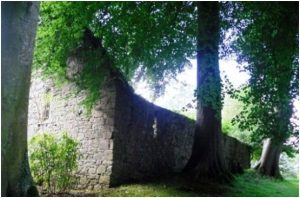 Lewis (1837) describes ‘a vestige of antiquity’ on the island opposite the Tontine, called Inis Cluain.
Lewis (1837) describes ‘a vestige of antiquity’ on the island opposite the Tontine, called Inis Cluain.
This ‘vestige of antiquity’ was established in 1291, when Ronald de Burgo gave his consent to a group of Franciscan monks to use the island to set up a small monastery. The presence of an Abbot is indicated by two cross slabs set into the stonework of the small church.
Joe Carroll continues the story; “in earliest times Cloon Island or, as it was then known, Inis Cluain stood completely separated from the rest of Castleconnell and was surrounded by deep fast flowing water.” The only access to the island was by boat. The monastery lasted until the sixteenth century when the monks were driven off the island and the church destroyed, leaving only the ruins which are visible today.
References:-
– A History and Topography of Limerick City and County, in A Topographical Dictionary of Ireland, (1837) Mercier Press
– Joe Carroll and Pat Tuohy Village by Shannon, the Story of Castleconnell and its Hinterland (1991)
St. Joseph’s Church Castleconnell
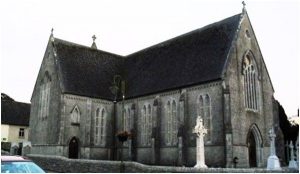 The building of the present Roman Catholic Church in Castleconnell was undertaken by Fr. Pat Hennesy PP, a native of Macroom Co. Cork, just ten years after the Great Famine. A site in the centre of the village was granted by Sir Richard De Burgho, of Island House, who also donated £40.00. The church was designed by the then Limerick City Engineer, William Corbett who lived in Castleconnell. The church was built by Launcelot Ryan from Newport, Co. Tipperary and the contract price of £2,000 laid down the building and roofing of the church, erection of a belfry and one gallery over the main entrance. The high altar, the stained glass window and bell were not included in the contract. On the 2nd September 1858 Fr. Hennessy laid the foundation stone of Castleconnell’s new church and work began in earnest.
The building of the present Roman Catholic Church in Castleconnell was undertaken by Fr. Pat Hennesy PP, a native of Macroom Co. Cork, just ten years after the Great Famine. A site in the centre of the village was granted by Sir Richard De Burgho, of Island House, who also donated £40.00. The church was designed by the then Limerick City Engineer, William Corbett who lived in Castleconnell. The church was built by Launcelot Ryan from Newport, Co. Tipperary and the contract price of £2,000 laid down the building and roofing of the church, erection of a belfry and one gallery over the main entrance. The high altar, the stained glass window and bell were not included in the contract. On the 2nd September 1858 Fr. Hennessy laid the foundation stone of Castleconnell’s new church and work began in earnest.
Every farmer gave a load of sand or gravel, those who owned horses and carts drew stones from Ballysimon quarry. Labourers went to the quarry to blast out stone and bring rubble to the kiln to have it burned into lime. Tradesmen too gave some free labour to help the builder. Jasper White donated the stained glass window and bell. Following many fundraising feats, by July 1863 the church was finally completed and ready for worship. There was not enough money left to erect the High Altar and a temporary altar was constructed for the consecration ceremony which was scheduled for Sunday 9th August.
The consecration ceremony was performed by the Bishop of Ross. The new church was dedicated to St. Joseph. High Mass commenced at midday celebrated by Rev. Dr. Power who was joined by up to 20 priests from the diocese.
In 1864, Helenus White of Belmont House presented the beautiful High Altar to Castleconnell Church. In the intervening years two side altars were also erected on each side of the High Altar, one to the Sacred Heart and the other to the Blessed Virgin. Two more galleries were erected in the east and west trancepts to accommodate the increasing population. The Stations of the Cross were also donated and a memorial name plate was fixed on the wall under each Station. The interior furnishing of the church was completed with the installation of a beautifully ornamented Communion rail in finely turned wrought iron and brass with a pair of hinged gates in the centre. According to Joe Carroll and Pat Tuohy ‘one of the outstanding and enhancing features of this beautiful rail was its marble setting. The kneeler and capping were of Carrera marble… specially imported from Italy… With the images of the Sacred Heart, and the Blessed Virgin on the side altars, there were also statues of St. Joseph, St. Patrick and St. Anthony in the sanctuary, a baptismal font at the front entrance and three confessionals’, this was the church interior in its original state and was to remain so for more than a hundred years. With Pope John XXIII came Vatican Two. As was the policy of the time, the statues were removed from the Church. The only remaining feature from that time is the stained glass window behind the sanctuary which still retains its glorious colour and splendid detail. Irrespective of these “changes” St. Joseph’s Church is an imposing elegant stone structure in the heart of Castleconnell where generations of people have worshipped and thankfully continue to do so.
References:-
– Joe Carroll and Pat Tuohy Village by Shannon
St. Patrick’s Church, Ahane
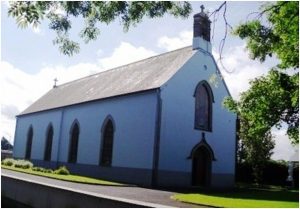 St. Patrick’s Church was to replace the mud and wattle Mass House which had been erected near Biddyford in 1758.
St. Patrick’s Church was to replace the mud and wattle Mass House which had been erected near Biddyford in 1758.
According to Lewis (1837) the church in Killeenagarriff (Ahane) had “in attendance…about seven hundred”. It was commenced by Fr. Crotty PP in 1838, on a site donated by Richard Bourke. As with St. Joseph’s Church Castleconnell, there was much local involvement in the building of the church. A builder named Coughlan from the Mardyke in Limerick erected the church. The beading which surrounds the Church door came from the thirteenth century Franciscan Abbey in Quin, Co. Clare. Three men went with horses and carts, stayed overnight and returned the next day with the makings of the arch which remains a prominent feature to this day.
Francis Speight, (a local politician) donated the timber and supplied the slates. There was a slight interruption to the building process when “The Big Wind” did some damage in 1839, literally blowing down half the roof. However, undaunted, work continued apace. The stones for the church came from the local limestone quarry at Ballyvarra, which was owned by Paddy Maher. The Howley family of Rich-hill donated the bell, which came from India. Inside the church, the Nevin family of Mountshannon donated the Stations of the Cross which are located on either side of the walls. These stations, carved from wood, were originally intended for a church in Germany. Nevin purchased them in New York in 1906 and donated them to the church in Ahane in remembrance of his daughter. The first child to be christened in the “new” St. Patrick’s Church was Tom Moynihan of Biddyford.
The Church at that time was much different to the church we have today. The altar was a wooden structure. Surrounding the altar was a timber altar rail. Inside the railings were two seats, one on either side of the altar. One seat was for the Howley family and the other was for the Graham family. There were two doors on either side of the altar. Over each of these respective doors was what was described as a ‘wooden baton gothic recess ‘ One recess contained a statue of Our Lady with the baby Jesus, or St. Teresa, memories on this vary. The other contained a statue of the Sacred Heart.
Unlike today’s style, the Church in Ahane had three rows of pews; two side rows of small seats and a row of large seating in the middle. The pews were ‘owned’ by various members of the community. This was seen by many, as a way for the Church to raise some badly needed cash at the time. ‘The church was unable to meet the cost themselves, and asked the people to subscribe for a seat. The people’s names were written on the seats, and they sat in their seats for the duration of their worship’. The same principle applied in St. Joseph’s Church Castleconnell.
Three major renovations took place to date in the history of St. Patrick’s Church. One was under the auspices of Canon Devaney in 1940. There is a plaque erected to his memory on the wall, close by the altar in the Church. The other in the late ’60′s and the final renovation to date took place in 1977 under the auspices of Fr. Cooney.
When the Church was being renovated in 1940, (the first since the Church was built) Mass was offered in the old school house in Ahane. With Pope John XXIII came Vatican Two. As was the policy of the time, the statues were removed from the Church. The Mass was no longer said in Latin, but in the vernacular i.e. the language of the people.
Once again, in 1977 reconstruction took place in St. Patrick’s Church Ahane. This time it was under the auspices of Very Rev. John Cooney P.P. The cost of this renovation was £45,000. The chief contractor was Michael Cusack. Local architect P.J. Leyden laid out the plans and specifications for the renovations. The Limerick Leader stated that ‘subcontracting was undertaken by local men’.
A new sacristy was erected at this time too, while ‘a considerable donation’, was given towards the cost of the organ. A new altar was erected to facilitate the changes enacted, by Vatican Two. Bishop Michael Harty re-dedicated the Church. During the concelebrated Mass, Dr. Harty referred to the ‘island parish of Ahane’, (Castleconnell), being as it is, the only parish in Co. Limerick to be a member of the Diocese of Killaloe. On that day too the bishop paid special tribute to the choir, saying they ‘were the most beautiful in any rural parish in the diocese of Killaloe’.
As was the case in the 1940′s, while renovations were being undertaken, Mass was celebrated in the national school in Ahane at the Cross of Laught.
As with the building of the Church in 1838, 140 years later, the people of the parish, did much voluntary work, to complete the church. That way costs were kept to a minimum.
The storm of Christmas Eve 1997 blew the Cross-to the ground. Once again local people rallied around to help in various ways to ensure that Mass was celebrated on that Holy Night. A Cross purchased from Co. Roscommon replaced the one which was blown down on Christmas Eve.
On December 15th 1998 Dan Richardson passed away and bequeathed bells to the Church. Now the Angelus bell rings out twice a day as does the ‘quarter bell’ to call people to Mass each Sunday and holy day.
References:-
– A History and Topography of Limerick City and County, in A Topographical Dictionary of Ireland, (1837) Mercier Press
The Oratory at Montpelier
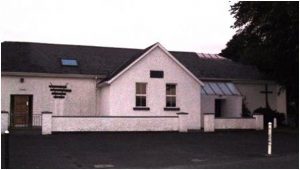 In the late 1980’s Bishop Harty approved the provision of a new oratory on the site of the old national school in Montpelier. It was opened and dedicated to Saint Theresa in May 1989.
In the late 1980’s Bishop Harty approved the provision of a new oratory on the site of the old national school in Montpelier. It was opened and dedicated to Saint Theresa in May 1989.
There you have it; the story of a Parish and its faith, as told by the ruins and the existing Churches which have survived through the centuries.
Fr. Minogue Diamond Jubilee Mass of Thanksgiving, St. Joseph’s Church, Castleconnell
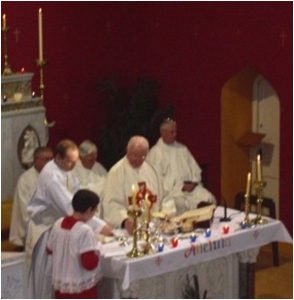 Lest you think that all our history is written in stone, last year we had a double celebration in our parish, with Fr. James Minogue celebrating his Diamond Jubilee and the ordination of Fr. Ger Fitzgerald to the priesthood. It was a year of joy and celebration in the parish.
Lest you think that all our history is written in stone, last year we had a double celebration in our parish, with Fr. James Minogue celebrating his Diamond Jubilee and the ordination of Fr. Ger Fitzgerald to the priesthood. It was a year of joy and celebration in the parish.
Fr. Ger Fitzgerald Ordination Mass, St. Joseph’s Castleconnell, Co. Limerick
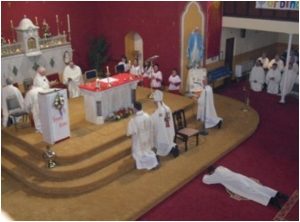 This year we celebrated Pride of Place in Castleconnell. The combined choirs of St. Joseph’s Church Castleconnell and All Saints Church, Stradbally sang a selection of hymns for the judges on the day. It too was a wonderful Ecumenical celebration, bringing together both communities for the good of all.
This year we celebrated Pride of Place in Castleconnell. The combined choirs of St. Joseph’s Church Castleconnell and All Saints Church, Stradbally sang a selection of hymns for the judges on the day. It too was a wonderful Ecumenical celebration, bringing together both communities for the good of all.
This is our parish!
[1] A History and Topography of Limerick City and County, in A Topographical Dictionary of Ireland, (1837) Mercier Press.